Adedire F. M., Adegbile M. B. O.
Department of Architecture, University of Lagos, Lagos, Nigeria
Correspondence to: Adedire F. M., Department of Architecture, University of Lagos, Lagos, Nigeria.
| Email: |  |
Copyright © 2017 Scientific & Academic Publishing. All Rights Reserved.
This work is licensed under the Creative Commons Attribution International License (CC BY).
http://creativecommons.org/licenses/by/4.0/

Abstract
This research aims at examining the factors influencing housing characteristics in Lagos peripheral settlements. Using case study strategy, eighteen peri-urban settlements in Ikorodu, a Local Government Area outside Lagos Metropolitan region, were selected for this study. Data was collected through primary and secondary sources which include survey questionnaires and direct observations. Using two stage sampling techniques, questionnaire was distributed to households in purposively selected peri-urban settlements. Data collected through field survey were analysed using frequencies, percentages, cross tabulations and test of correlation while qualitative data were analysed using descriptive analysis. Findings revealed the major factors influencing housing characteristics in the study area are housing initiatives, residential segregation and residents’ socio-economic attributes. Different housing initiatives in the study area performed differently in terms of typology and resident’s perception. Socio-economic attributes revealed a multi-cultural households composition, reasonable literacy level. It is recommended that improved and timely regional policy response to the pace and pattern of development of housing development under the self-help housing initiative in Lagos peri-urban settlements would help in curbing high level of informality and also ensure a high quality and user performance peri-urban housing developments.
Keywords:
Peripheral, Housing characteristics, Informality, Residential segregation, Building materials
Cite this paper: Adedire F. M., Adegbile M. B. O., Factors Influencing Housing Characteristics in Lagos Peripheral Settlements: Case of Ikorodu, Architecture Research, Vol. 7 No. 5, 2017, pp. 191-200. doi: 10.5923/j.arch.20170705.01.
1. Introduction
The characteristics of housing development in the peri-urban are influenced by many factors some of which are policy induced. Common factors contributing to the divergence in the morphology of the housing development in the metropolitan fringe are urban policy, residents’ socio-economic characteristics, the locational quality, building design, construction materials, housing initiatives (Minghong & Xiubin, 2013). Need, scale, style and location are also determinants of housing typology. Household size, the floor space per person for living and working, land intensity are also the primary determinants in classification of housing. (Ravetz, Fertner, & Nielsen, 2013). In addition, housing classification is established by society, affordability and platform in form of government-led, private development-led and self-help housing. Housing in Lagos peri-urban exists under three types of initiative and governance: self-built housing development, private developer - led housing and state-led housing development. Each initiative has distinct characteristics, mode of construction, ownership status and tenure. The migrants’ suburb is characterized by self-help housing while the well planned new towns are mainly government-led housing development in the peri-urban. Government-led housing development usually calls for replacement of the original settlers’ culture group by residential diffusion differentiated by ethnicity and culture. It allows structured inequality and results in residential segregation which ultimately lead to disparity in infrastructure development. It is high absorbed peri-urban housing development.The self-help housing development is the peri-urban is influenced by the socio-economic attributes of the residents which impact the dwelling quality, construction materials and arrangement. In most cases, peri-urban housing is characterised by low density mixed-use residential development. Rigidly segregated housing with limited choices in travel routes is prevalent in the metropolitan fringe (Yue, Liu, & Fan, 2013). The concept of mixed-used development, mixing residential with commercial and service functions emerged to address the multi-dimensional needs of the heterogeneous population in peri-urban developments (Tavares, Pato, & Magalhães, 2012; Tan & Li, 2013). The negative impact of mixed-use development in usually in term of environmental pollution created by discharge of toxic wastes which affect both dwelling and environmental quality in peri-urban settlements. Housing type is characterised by different types of neighbourhood in the peri-urban. Common housing typologies in the peri-urban are commodity housing (rooming house), single family house, a single family bungalow, semidetached bungalow, storied apartment building and middle rise buildings duplex (Olotuah, 2006). The commodity housing has co-renting as its unique attributes. It is called rooming apartment and it is characterized by one apartment sub- divided into numerous bedrooms. It services the poor migrants in the metropolitan fringe (Mandere, Ness, & Anderberg, 2010). Housing characteristics in Lagos peri-urban settlements are a cluster of settlements along the axial of the urban corridor of the Lagos-Ibadan expressway. Major land use in Lagos peri-urban is residential development. Urban morphology in Lagos peri-urban follows the trend of construction of housing estates on acquired large tracks of land (Tavares, Pato, & Magalhães, 2012).Housing in Lagos peripheral settlements is characterised mostly by mismatch properties between the users and the spatial planning. The complexity of the heterogeneous population in the peri-urban calls for participation of the end users in the design framework. These factors known to have strong influence on housing characteristics must be made available for consideration in order to have a user performance and effective housing development in the peri-urban. Therefore, this study aims to identify the factors influencing housing characteristics in Lagos peripheral settlements. Findings will be helpful for the stakeholders in achieving appropriate housing delivery strategy by housing providers in terms of the provision of an efficient and user responsive housing units.
2. Literature Review
Housing in the peri-urban exists under three types of initiative and governance: self-built housing development, private developer - led housing and state-led housing development (Shen & Wu, 2013). Self-help housing grew as a result of aggravated housing demand increased preference for single family houses (Gough & Yankson, 2000) and it is the most predominant housing initiative in peri-urban development zones. Under this initiative, individual household takes responsibility for the construction of their housing units. Self-help housing is mostly located in the. Generic attributes of most self-help housing development in developing countries are poor construction, unavailability of standardized designs and limited infrastructure connectivity (Bangdome-Dery, Eghan, & Afram, 2014). State-led housing development is aimed at driving the growth of the metropolitan fringe. It is accompanied with land acquisition and meagre compensation to the original landowners. Private developer-led housing development is formally regulated and predominantly occupied by middle class and higher income migrants from the city centres (Simon, 2008).Socio economic status of residents has significant influence on the housing typology in the peri-urban. The types of housing development are a function of the socio- economic composition of the residents. Residents with lower socio-economic status occupy different spatial form of settlements, these are often characterized by squatter settlements. Socio-cultural composition of peri-urban residents’ constitute migrants from other places, residents from the inner city and local natives. Poverty contributes to the environmental quality in the interface. Differentiating factors between the peri-urban resident groups could be through either socio-economic factors, personal motivation for housing, housing choices preference or the resulting spatial differentiation. In the peri-urban, using socio-economic attributes, the most significant differentiating factor that distinguishes migrants from other resident groups is housing tenure. Non migrant groups are mostly home owners regardless of socio economic status. Rural migrants constitutes the root of rental housing in the peri-urban. This class of people eventually settles in low cost private rental houses in the peri-urban (Shen & Wu, 2013).Residential segregation emerges as a result of people tendency to live in a residential community with some characteristics like language, race and social class in the peri-urban. There are different levels of residential segregation, residential segregation by education level and income, segregation by housing typology, existence of solid gate segregation by internal kinship and segregation by social class (Pradoto, 2012). Residential segregation is mostly influenced by income level and education level as this impact people's ability to live in an exclusive residential area (Pacione, 2009). Residential segregation can be viewed as an isolation of a certain community in a certain residential area usually separated from mainstream community due to several reasons like policy and solid residential gate (Fitra & Pradoto, 2014). The separation of residents with dissimilar identities creates a social exclusion ultimately leading to residential segregation (Fitra & Pradoto, 2014). Spatial segregation and social fragmentation is aided by social and cultural preferences for housing locations. Settlements are segregated by kinship, income level and income groups. Socio-spatial segregation encourages gated communities, removal of local community services and urban sprawl. Gated communities create spatial differentiation between the exclusive housing and the urban space in which they are located bringing development disparity. Residential segregation results in the absence of interaction between social groups and unequal distribution of societal groups in the physical space (Firman, 2004; Pradoto, 2012). Residential segregation induces spatial fragmentation and social segregation. It hinders balanced developments (Firman, 2004). Low income groups are mostly confined to the core with little or no infrastructure development (Cobbinah & Amoako, 2012). Lower class in the peri-urban is usually segregated unintentionally while the upper class is segregated intentionally. Housing in the peri-urban interfaces in almost all the developing countries is predominantly informal buildings with no conformity to building regulations. The types of settlement are a function of the socio-economic composition of the peri-urban. Residents with lower socio-economic status occupy different spatial form of settlements, these are often characterized by squatter settlements. Most Nigerian peri-urban housing is conceptualized as a squatter settlement, illegal areas, and low priority areas in term of municipal planning (Tavares, Pato, & Magalhães, 2012). Causes of inadequate infrastructure in peri-urban settlements are growing number of informal housing for low income groups, informal housing not served by basic infrastructure, housing density outweighs the pace of infrastructure development. A dynamic of two types of settlements co-exist. One is affluent and integrated into the city with good transportation while some are isolated, poor and over populous, (Simon, 2008).Most peri-urban lack efficient land use planning and infrastructure leading to the emergence of informal settlements (Allen, 2003). Poverty contributes to the environmental quality in the interface. The increasing migration composition of Lagos State constitutes a socio-spatial mixture as opposed to the existing structure rooted in kinship, ethnic homogeneity and communal land tenure before the surge in urbanisation (Towry-Coker, 2002). Differentiating factors between the peri-urban resident groups could be through either socio-economic factors, subjective motivation for housing, housing choices preference or the resulting spatial differentiation.
3. Case Study
The case study used is Ikorodu Local Government Area in Lagos State, a highly populous region in the Federal Republic of Nigeria. Ikorodu is located in the North East of Lagos State along the Lagos lagoon and situated at a distance of approximately 36km north of Lagos. According to the National Population Commission (2006) census, Ikorodu had an enumerated population of 535,619. The spatial scope of this research is limited to the identified peri-urban settlements in Ikorodu Local Government which covers 345 kilometers square. The sample frame constitutes the existing buildings in the peri-urban.  | Figure 1. Map of Lagos showing the study area |
4. Research Methodology
This study employs a case study methodology in the field survey. The case study approach was applied by conducting field research covering the three tiers of housing that is, self-help housing, private developer-led housing development and government-led housing development. Primary data was sourced from the questionnaire instrument and the observation schedule through a survey of purposively selected 18 settlements in the peri-urban of Ikorodu. Two-stage sampling was adopted in selecting the sample size made up of randomly selected 384 housing units in the study area. A total of 384 questionnaires were administered to heads of housing units and 379 questionnaires were retrieved. Descriptive analysis was conducted on the data to generate percentages and frequencies of respondents’ socio-economic characteristics, housing initiatives, housing typologies, tenure, building materials, factors for informality and segregation in the study area. Secondly, regression analysis using test of correlation was used to identify the relationship between the variables considered to have influence on housing characteristics in the study area. Data processing and analysis for this study were carried out using the Statistical Package for Social Sciences (SPSS) 22 for windows for statistical analysis of the quantitative data.
5. Data Presentation and Discussion
5.1. Socio-Economic Attributes of Respondents in the Study Area
Five distinct household sizes were found in Ikorodu peri-urban settlements (Table 1). The most prevalent household size is composed of 3-5 persons and this constitutes about 48.8% of the sampled households. Household sizes of 1-2 people and 6-9 persons constitute 23.2% and 23% respectively. Also, household size of more than ten persons, 10-12 comprises about 3.7% of the population. The least popular household size is that which is made up of more than 13 persons. This comprised of 1.3%. Informal trading is the most prominent occupation, 31.4% of the respondents were involved. Civil service was 23.7%. Skilled artisans were 17.7% and those engaged in professional practice were 14.8%. Less prominent occupations were studying (4.7%), farming (3.2%), unemployed (0.8%) and retirees (3.2%). There exist low illiteracy level in the study area, 5.5% had below secondary school education constituting the stipulated illiteracy level by UNESCO. The predominant ethnic group in the study area was the Yoruba ethnic group and the least represented was Hausa ethnic group. The middle income earners are the most predominant earning between N50, 000.00 to N150, 000.00 monthly. 46.9% of the total population sample was composed of this group while the low income group was 39.6% of the respondents. High income earners were just 13.4% of the population. The longest time most people have lived in Ikorodu peri-urban settlements fell within a period of five to ten years. Housing initiative in the study area came mainly from the self-help housing development comprising 71.5%. Government participation in housing development was insignificant at 2.6%. The second important player in housing development in the peri-urban settlements is the private developers, comprising 25.6%.Table 1. Socio-economic characteristics of the respondents
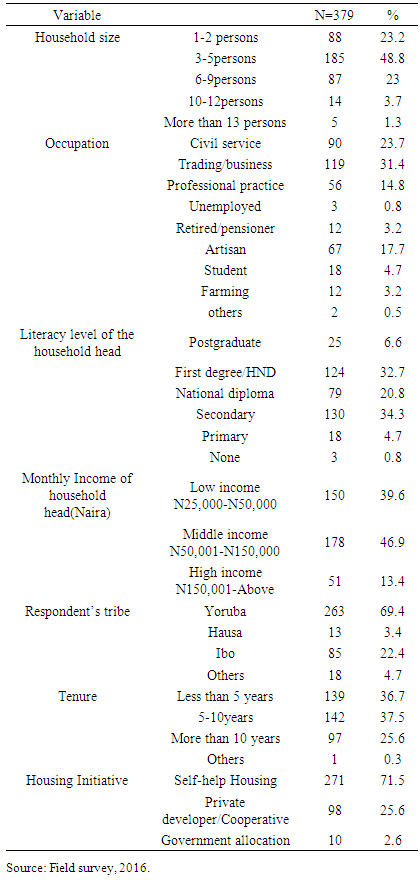 |
| |
|
5.2. Characteristics of Housing Developments in the Study Area
5.2.1. Housing Typologies in the Study Area
Characteristics of housing in this study will be reviewed based on housing typologies, units of household per building and the number of rooms per household. There are also different housing typologies in Ikorodu peri-urban settlements, each driven by the peculiarities of the location, characteristics of the migrants and also the housing initiatives. As shown in Table 2, the regular housing typologies in Ikorodu were single family bungalow unit (47.2%), two family semi-detached bungalow (15.3%), single family storey housing (13.2%), tenement bungalow housing (9.2%), storey blocks of flat (4.7%), and multiple unit row bungalow housing (4.2%) in order of occurrences. Other existing but not popular housing typologies were tenement storey building (2.4%), semi-detached duplex (1.6%), two family semi-detached storey building (1.1%), single unit traditional housing (0.5%), multiple unit traditional housing (0.3%). The most prevalent housing unit in the study area is the single family unit bungalow. It is mainly owner occupied and not part rented. Two families semidetached bungalow housing in the peri-urban is partly owner occupied and partly rented out. The single storey family housing is wholly owner occupier especially among the polygamous families in the peri-urban. Two family semi-detached storey housing units also exist and are similar to the two families’ semidetached but different in the storey. The owners usually occupy one unit of the whole housing while the other wing is rented out. The semidetached duplex housing unit shares a similar function with the two family semi-detached storey housing unit but different in the internal spatial arrangement. It is widespread in developer-led housing and also among the middle income earners. Block of flats storey housing and tenement unit bungalow housing are built mostly and purposely for profit and mostly not occupied by the owners. They are rental housing, sharing communal sanitary facilities, built for low income and the poor in the peri-urban. It is primarily used by students in the higher institutions located in Ikorodu peri-urban. Multiple unit row housing is similar to additional rental housing but consists of many households units on the same parcel of large lands built for rental purpose. Tenement storey building is a bigger form of commodity housing. It has a ground and first floor but each floor has rows of sanitary facilities communally shared together. Single unit traditional housing and multiple units traditional housing are the regular housing unit among the natives, they have part rented out, built to be lived in by all extended families and usually with poor quality building materials. It is more of an inheritance housing in the peri-urban.Table 2. Housing typologies in the study area
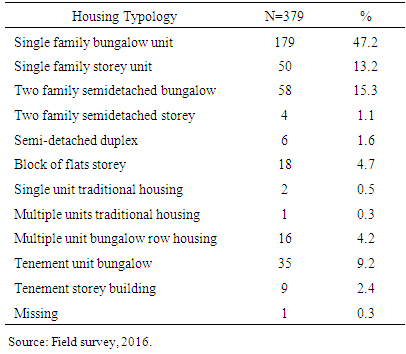 |
| |
|
5.2.2. Analysis of Occupancy, Ownership Status and Spatial Planning
The commonest household units per building type as shown in Table 3 are 0-2 units, 55.4% and 3-4 units constituting 19.3%. Other existing household units per housing are 5-6 units (10%), 7-8 units (6.9%) and more than 8 household units (8.4%). There are different rooms per household units, ranging from 0-2 rooms (21.6%), 3-5 rooms (34%), 6-9 rooms (21.9%), 10-12 rooms (11.1%), and more than 13 rooms (11.6%). The dominant housing occupation in Ikorodu peri-urban settlements is a part rented occupation (57.8%). Full family occupation housing units in Ikorodu were 41.4% and other unspecified types were 0.95%. In term of ownership, the commonest types are self-built and owned housing (56.5%), family built and owned housing (10.3%) and tenant self-paying tenant ownership (26.1%). Other ownership status are government built and owned (2.6%), unknown family built (2.4%) and tenant non-paying (1.3%). Further indicated by the analysis of the questionnaire, owner-occupiers (58.3%) were higher than renters (35.1%) in Ikorodu peri-urban. Few people also were pulled to the peri-urban for commercial purpose (5.8%).Table 3. Analysis of housing characteristics in the study area
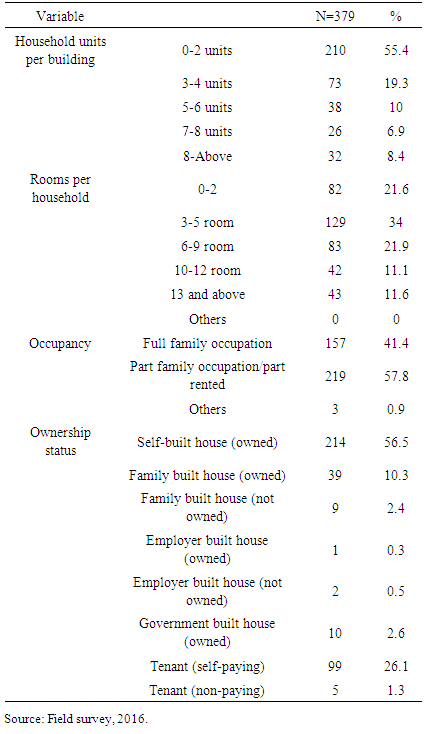 |
| |
|
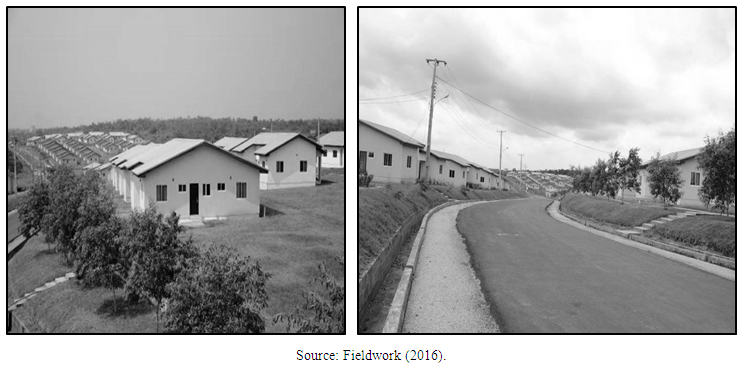 | Figure 2. Low cost government-led housing scheme in Agbowa, Ikorodu |
 | Figure 3. Private developer-led housing scheme in Ikorodu, Lagos |
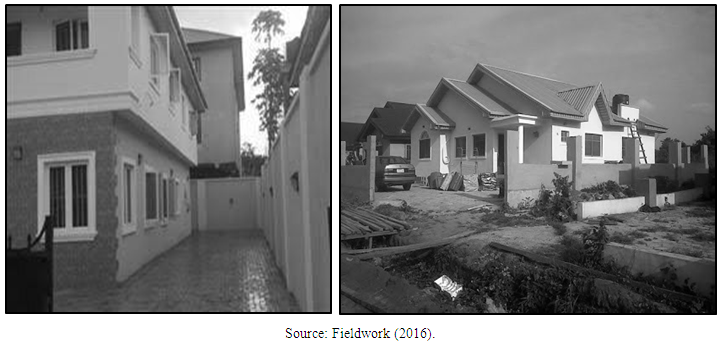 | Figure 4. Typical self-help housing development scheme in Ikorodu, Lagos |
5.2.3. Building Construction Materials in the Study Area
Through observation schedule and the analysis of field survey, there were diverse building materials in the study area. As indicated in Table 4, the prevailing wall material was block wall (94.5%), mud and thatch wall are sparingly used in the order of 2.9% and 2.4% respectively. The roofing material used mostly in Ikorodu was Aluminum (58.8%). Thatch, concrete slab and other unidentified roofing materials are also used in order of 16.4%, 12.4% and 12.1% respectively. The commonest window material in the study area was aluminum, representing 64.1% of the analysed data. Louvre, wooden and casement windows were also represented in order of 19.5%, 14.8% and 1.3% respectively. Steel and wooden doors were more pronounced in use than glass doors in the peri-urban.Table 4. Analysis of Building Construction Materials in the study area
 |
| |
|
5.2.4. Informality in the Study Area
Different variables were put into consideration in the measurement of informality in the selected peri-urban settlements. They are the plot size for building, setback around the building, setback from the road, availability of building permit and basic building regularisation documents. Analysis of data from the fieldwork as shown in Table 5 shows the extent of informal housing development Ikorodu peri-urban settlements. Among 379 respondents in Ikorodu, 67.8% were built on a standard plot while 29.6% were not, also there were 2.1% missing system and 0.5% respondents chose neither of the responses. On setback around the house, 55.1% households observed standard setback around the houses while 42.5% defaulted. There was 2.1% missing system and 0.3% chose neither of the responses. A smaller percentage of the households, 41.7% observed the standard setback from the road while 56.2% household did not. Only 38.8% households had building permits, 52.2% households lacked building permits, 17% chose neither in their responses and there were 74% missing systems. The responses of households to building regularisation documents were poor.Table 5. Analysis of measurement of Informality in the study area
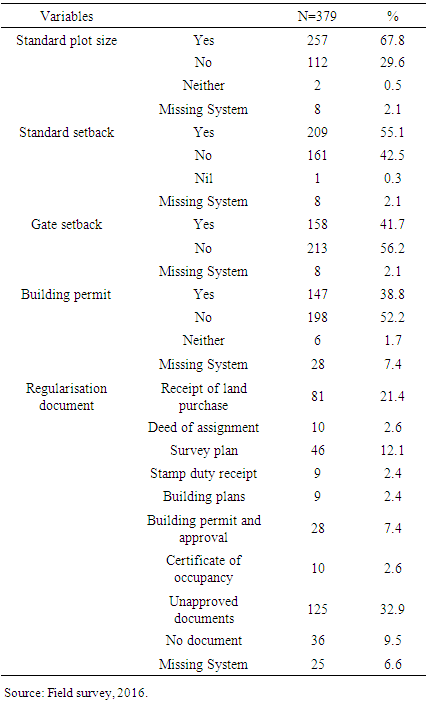 |
| |
|
5.2.5. Environmental Quality in the Study Area
The variables considered for measuring environmental quality in this study are appropriate waste disposal system, a good drainage system and the state of roads. Analysis of the field survey (Table 6) shows good waste disposal system is also lacking in most places in Ikorodu peri-urban as indicated by 72.8% of the respondents’ population. Only 26.4% shows satisfaction with access to good waste disposal system. Drainage system is a great issue in the study area, 80.2% of the respondents were affected by poor drainage systems while 18.8% live in places with good drainage. Observation shows that most secondary roads in Ikorodu are not good. Graded and ungraded earth road is the prevailing road types in Ikorodu peri-urban settlements. These findings corroborate the findings through the investigation by Lawanson, Yadua & Salako (2012) and Chirisa (2013) on the state of poor environmental quality in peri-urban settlements.Table 6. Respondents' assessment of environmental quality
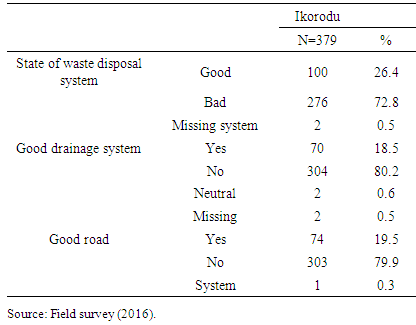 |
| |
|
5.3. Limitations in Housing Initiatives and Characteristics in the Study Area
With reference to the analysis shown on housing characteristics and observation in the field survey, lack of government involvement in self-help housing is the major cause of extreme informality in the study area (Table 5). The analysis of building materials shows slight use of traditional building materials leading to affordability problem because of preference for conventional building materials. Interview conducted with residents of government-led and private developer-led housing developments shows inappropriate building design in terms of floor area. These housing providers did not put into consideration the dominance of the low income group in the peri-urban. This could be attributed to the exclusion of end users in the design stage. Also, apart from an affordability issue, most private developer housing and public housing are poorly located and suffers from poor locational quality. This factor limits patronage of such housing in Ikorodu peri-urban settlements.
5.4. Factors Influencing Housing Characteristics in the Study Area
5.4.1. Correlation between Housing Initiatives and Typologies
The correlation analysis presented in Table 7 shows there is a significant relationship between housing initiatives and housing typology in the study area (0.166** P<0.05). This signifies that there is a relationship between housing initiatives and typologies in the study area.Table 7. Correlation between housing typologies and housing initiatives in the study area
 |
| |
|
5.4.2. Correlation between Housing Typologies and Respondents’ Socio-economic Attributes
The test of correlation between housing typologies and respondents’ socio-economic attributes(Table 8) shows that income, community and ethnic group show significant relationships with housing typologies (-0.132** P<0.10; 0.138** P< 0.05; -0.144** P<0.005). Therefore, housing typologies is influenced by respondents’ socio-economic attributes in the study area.Table 8. Correlation between housing typologies and respondents’ socio-economic attributes
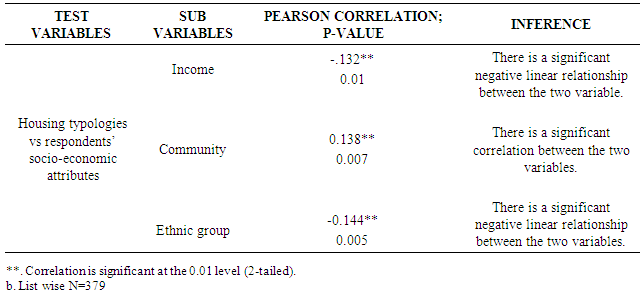 |
| |
|
5.4.3. Correlation between Housing Segregation and Respondents’ Socio-economic Attributes
Residential segregation in the study areaTribe, income and education are the primary factors driving residential segregation in Ikorodu as shown in the correlation test in Table 9 with significance level at 0.001 and 0.000, there exists a significant linear relationship between residential segregation by gate and the three notable socio-economic factors. The correlation analysis shows there is a significant relationship between residential segregation and respondents’ tribe, income, education and occupation (-0.164** P<0.01; -0.220** P< 0.01; 0.219** P<0.01 & 0.164** P<0.01). This analysis shows that residential segregation is influenced by residents’ socio-economic attributes.Table 9. Test of correlation between residential segregation and respondents’ socio-economic attributes in the study area
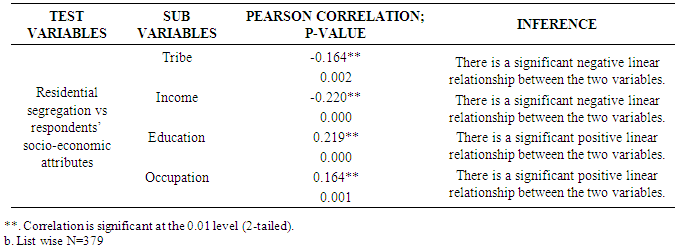 |
| |
|
6. Conclusions
Identified housing typologies in Ikorodu peri-urban settlements are single family bungalow unit, single family storey housing, two family semidetached bungalow, two family semi-detached storey building, semidetached duplex, blocks of flats, single unit traditional housing, and tenement housing. Among these, commonest housing type in the study area was the single family bungalow housing and single family storey building constituting 47.2% and 13.2% respectively. The least occurring building types in both locations were the tenement and single traditional housing. The commonest type of housing units per building was 0-2 units per dwelling and the commonest type of rooms per household was 3-5 rooms. In terms of housing occupancy, Self-built and owned housing was lower in Ikorodu. Most of housing development, 57.8% were part rented housing occupation. Prevailing building materials in the study area were conventional building materials like cement sandcrete blocks, aluminium, aluminium roofing, burglar-proofed windows, wooden panel internal doors and steel external doors. Few buildings among self-help housing were built with traditional building materials like mud block, thatch roofing sparingly in the peri-urban. Both government-led housing and developer-led housing rely much on the use of conventional building materials. Findings show no trace of alternative building materials for the mentioned housing initiatives in the peri-urban. Informal development which in this case means illegal development is aided by government poor policy towards the method and cost of housing regularisation in the peri-urban. Violation of spatial plan can be attributed to ineffective policy responses to residents’ character, there is no effective sanction in place as a control mechanism thus aiding further violation of planning laws by individuals and corporate. The test of correlation shows that housing characteristics in the study area are influenced by socio economic attributes of the residents in the study area. Major socio-economic attribute that affects housing typology are income, community and ethnic group. The implication of this is that the less the income, the less the quality and standard of housing typology that can be assessed. Residential segregation is influenced in the peri-urban settlements by socio-economic attributes like income, tribe, education, community and occupation. It can be concluded that the major factors influencing housing characteristics in the study area are housing initiatives, residents’ socio-economic attributes, residential segregation and building materials.
7. Recommendations
Advocacy for housing policy that encourages the use of alternative building materials by the government and private developers will aid housing affordability in the peri-urban. A policy framework to standardize design to serve the various income groups and household sizes should be set up. This can be achieved by creating a portfolio of the socio-economic characteristics of the residents. Also there should be an inclusion of the end users in the design stage, especially projects targeting low income group and middle income group, to help in achieving appropriate housing delivery strategy by housing providers in terms of the provision of an efficient and user responsive housing units. Post occupancy study should be carried out in government and private housing development to determine their efficiency and suitability for the peri-urban settlements. This will enhance performance standard in other housing projects to be implemented. Finally, regional and state government should intervene in the housing process of self-help housing development in terms of education on spatial adequacy, dwelling quality, suitability of construction materials to be used and in subsidizing the building regularisation assessment fee.
References
| [1] | Allen, A. (2003). Environmental planning and management of the peri-urban interface: perspectives on an emerging field. Journal of Environment and Urbanization, 15(1), 135-147. |
| [2] | Bangdome-Dery, A., Eghan, G. E., & Afram, S. O. (2014). Overview of Self-Help (Self-Build) Housing Provision in Ghana:Policies and Challenges. Developing Country Studies, 4(6), 77-89. |
| [3] | Cobbinah, P. B., & Amoako, C. (2012). Urban Sprawl and the Loss of Peri-Urban Land in Kumasi, Ghana. International Journal of Social and Human Sciences, 6(1), 388-397. |
| [4] | Fitra, H. A., & Pradoto, W. (2014). The Influence of Social Behavior to The Emergence Residential Segregation in Sleman Regency D.I Yogyakarta. Jurnal Pembangunan Wilayah dan Kota, 10(3), 235-247. |
| [5] | Firman, T. (2004). Demographic and spatial patterns of Indonesia's recent urbanisation. Population, Space and Place, 10(6), 421-434. |
| [6] | Gough, K. V., & Yankson, P. W. (2000). Land Markets in African Cities: The Case of Peri-urban Accra, Ghana. Urban studies, 37(13), 2485-2500. |
| [7] | Mandere, N. M., Ness, B., & Anderberg, S. (2010). Peri-urban development, livelihood change and household income: A case study of peri-urban Nyahururu, Kenya. Journal of Agricultural Extension and Rural Development, 2(5), 73-83. |
| [8] | Minghong, T., & Xiubin, L. (2013). The changing settlements in rural areas under urban pressure in China: Patterns, driving forces and policy implications. Journal Landscape and Urban Planning, 120, 170-177. |
| [9] | Olotuah, A. O. (2006). Housing Quality In Suburban Areas (An Empirical Study of Oba–Ile, Nigeria). Dimensi Teknik Arsitektur, 34(2), 133 - 137. |
| [10] | Pacione, M. (2009). Urban geography: A global perspective. USA: Routlegde. |
| [11] | Pradoto, W. (2012). Development patterns and socioeconomic transformation in peri-urban area. Berlin: Univerlagtuberlin. |
| [12] | Ravetz, J., Fertner, C., & Nielsen, T. S. (2013). The Dynamics of Peri-Urbanization. In K. Nilsson, e. al, & K. P. Nilsson (Ed.), Peri-urban futures: Scenarios and modals for land use change in Europe (pp. 13-44). Netherland: Springer-Verlag Berlin Heidelberg. |
| [13] | Shen, J., & Wu, F. (2013). Moving to the suburbs: demand-side driving forces of suburban growth in China. Environment and Planning, 45(8), 1823 – 1844. |
| [14] | Simon, D. (2008). Urban Environments: Issues on the Peri-Urban Fringe. Annual Review of Environmental Resources, 33, 167-185. |
| [15] | Tan, M., & Li, X. (2013). The changing settlements The changing settlements in rural areas under urban pressure in China: Patterns, driving forces and policy implications. Landscape and Urban Planning, 120, 170-177. |
| [16] | Tavares, A., Pato, R., & Magalhães, M. (2012). Spatial and temporal land use change and occupation over the last half century in a peri-urban area. Applied Geography, 34, 432–444. |
| [17] | Towry-Coker, L. (2002). Megacities: The Lagos example/ Nigeria. Konrad-Adenauer-Stiftung e. V. |
| [18] | Yue, W., Liu, Y., & Fan, P. (2013). Measuring urban sprawl and its drivers in large Chinese cities: The case of Hangzhou. Land use policy, 31, 358-370. |







 Abstract
Abstract Reference
Reference Full-Text PDF
Full-Text PDF Full-text HTML
Full-text HTML







